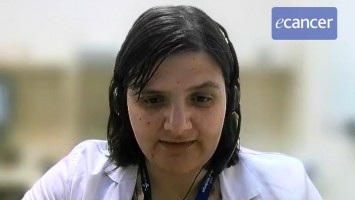I had the privilege this year of getting to present the first randomised trial of immunotherapy in sarcoma, looking at the combination of cabo, ipilimumab and nivolumab versus cabozantinib alone with crossover as an investigator-initiated trial. This was a 2:1 randomised trial looking at objective response rate as its primary endpoint, but we're also looking at clinical benefit rate, we're looking at response rate, we're looking at a huge profile of immune correlatives.
What we found is that the disease control rate actually doubled from 40% to 80% with the triplet compared to the combination. We actually saw response rates as people progressed by RECIST in the control arm and crossed over and added immunotherapy.
Another thing of a lot of interest is the fact that there were responders to a disease called leiomyosarcoma in all three conditions. So we saw leiomyosarcoma responses in cabozantinib with ipilimumab and nivolumab. Cabozantinib alone, they weren’t as deep or as prolonged. But then we actually saw two more leiomyosarcoma responses after RECIST progression when we added immunotherapy.
There are 69 patients in one arm and 36 in the other, and so in this randomization, we're dealing with small numbers. But the fact that we're seeing a consistent and repetitive signal in leiomyosarcoma where immunotherapy is not expected to respond. You know, we also saw responses in angiosarcoma and epithelioid sarcoma and myxofibrosarcoma; that was more expected in terms of what these agents do. But the signal within leiomyosarcoma is actually a groundbreaking new area to go into in terms of further clinical development.
Hopefully by the time the correlatives are done there will be a pathway forward for doing a much larger trial, especially within the area of leiomyosarcoma.
How can these results impact the treatment of soft tissue cancer in the future?
In terms of impact from this study, we now have an active triplet combination for IO, especially in the area of leiomyosarcoma. This now needs to be explored to figure out why and who is predicted to respond so that we can more finely tune how we’re using immunotherapy within the area of rare tumours. Because this is an area that has been underdeveloped and we’re now working very hard as a field.
What’s interesting is now we have a trial where we’re seeing a randomisation which is something I think needs to happen much more often because single-arm trials are hard to interpret. At the very end of our progression free survival curve, one of the things we finally see in sarcoma is a tail, sort of like we see in the melanoma data where there’s this tail of immunotherapy. We’re finally seeing one because we have a randomised trial and we can interpret what the IO curve looks like against a control. So as a field we’re moving forward, we need more randomised trials. I think the impact of this is it really does prove the need for randomisation. Hopefully we can work forward towards NCCN designation so more people can get access and potentially more of a formal randomised phase III.








